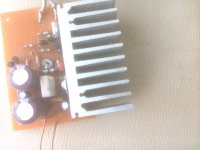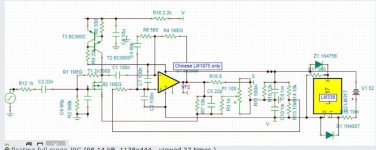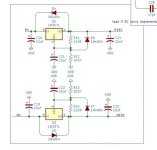Hello!
I would like to ask for advice, regarding any improvements to these chip amps designs from the 90s. It may be that this design is already as good as it gets...
I am using these (schematics attached) amps to drive Horn mids and Horn tweeters, which use little power due to their very high efficiency. I am using max of 1-3 w/ch into 6 ohm loads at the highest listening levels. I'd say usually staying under 1 watt!

1. I need balanced inputs (already included)
2. I am willing to try different dual opamps that are designed work in this configuration. I believe it is unity gain differential application.
3. Don't need headphone out, ignore this section
4. I there are other things to try, please share your thoughts. Is anything a clear deficiency?
Happy to keep this amp "as is" but also willing to try obvious improvements.
Thanks!!
I would like to ask for advice, regarding any improvements to these chip amps designs from the 90s. It may be that this design is already as good as it gets...
I am using these (schematics attached) amps to drive Horn mids and Horn tweeters, which use little power due to their very high efficiency. I am using max of 1-3 w/ch into 6 ohm loads at the highest listening levels. I'd say usually staying under 1 watt!
1. I need balanced inputs (already included)
2. I am willing to try different dual opamps that are designed work in this configuration. I believe it is unity gain differential application.
3. Don't need headphone out, ignore this section
4. I there are other things to try, please share your thoughts. Is anything a clear deficiency?
Happy to keep this amp "as is" but also willing to try obvious improvements.
Thanks!!
H
HAYK
May be this can change your mind.
https://www.diyaudio.com/community/...high-efficiency-speakers.399146/#post-7348792
https://www.diyaudio.com/community/...high-efficiency-speakers.399146/#post-7348792
HAYK,
thanks! So your suggestion is to use TPA3110 based amp with your ripple rejection and SMPS?
Maybe my next step but I have the existing amp and would like to get opinions on any reasonably possible ways to improve that design. Schematic was attached. Currently testing different opamps.
Already, I like the sound better with OPA2134 instead of original TL072. I will listen more.
thanks! So your suggestion is to use TPA3110 based amp with your ripple rejection and SMPS?
Maybe my next step but I have the existing amp and would like to get opinions on any reasonably possible ways to improve that design. Schematic was attached. Currently testing different opamps.
Already, I like the sound better with OPA2134 instead of original TL072. I will listen more.
I am a fan of lm4562 op amp. Superb sound. Classes ahead of tl72.
For 1875 I would add capacitance multiplyer or some voltage regulator it would have sonic benefits.
Very audible would be transformation of lm1875 to current drive. Look for "chip amp modification to current drive"
For 1875 I would add capacitance multiplyer or some voltage regulator it would have sonic benefits.
Very audible would be transformation of lm1875 to current drive. Look for "chip amp modification to current drive"
H
HAYK
As you don't need diff. input, get rid of the opamp and wire the input from the jack directly on the volume control. As you will use for high frequencies, replace the C102,C104 electrolytics with high quality polypropylene types of lower values to avoid bass go through. For tweeter 100nF C102 and 1uF for C104.
But I need to have balanced inputs. I believe that current drive modification is over my head. Only if it's available as a ready designed kit.
It's easy, to do, latest version of current drive lm1875 is this one
https://www.diyaudio.com/community/...fication-to-current-drive.389985/post-7231489
https://www.diyaudio.com/community/...fication-to-current-drive.389985/post-7231489
Guys, with current drive, what aspect of the sound changes? Is it robust or needs to be matched to the speaker load?
H
HAYK
You are driving horns. If each amp is driving both mid and high with crossover filter, the filter will not work the same way with current source. If you are driving each horn individually, The horn will be shouting on its driver's resonance with more pronounced high frequencies. What best you can get, not a current driven by but with adjustable output impedance. As you don't need much power you can get the same result by adding a series resistance with the horn.
Bellow is the composite circuit with adjustable output impedance 0.5 ohm to 5 ohm.
Bellow is the composite circuit with adjustable output impedance 0.5 ohm to 5 ohm.
Attachments
First do a listening test and measure frequency response and impedance.
The impedance should be linearized if not linear with calculated LCR or paralleled global 50 ohms/40 ohms/30ohms for mids and highs.
Or you use EQ from your media player/smartfone where you can find free apps for it. Or use eq like Behringer DEQ2496/minidsp.
For my loudspeaker projects with fullrange drivers I do not need to EQ bass and highs any more as current drive naturally adds these frequencies due to impedance rise at the ends. Here it makes the construction elegant and simpler.
Distortion goes down by 10-20db(!)
The impedance should be linearized if not linear with calculated LCR or paralleled global 50 ohms/40 ohms/30ohms for mids and highs.
Or you use EQ from your media player/smartfone where you can find free apps for it. Or use eq like Behringer DEQ2496/minidsp.
For my loudspeaker projects with fullrange drivers I do not need to EQ bass and highs any more as current drive naturally adds these frequencies due to impedance rise at the ends. Here it makes the construction elegant and simpler.
Distortion goes down by 10-20db(!)
Simple impedance linearization with paralleled resistor often helps classic voltage amplifiers to work better. If impedance would go too much down then resistor network in series and parallel can be used. All this linearized the impedance response and makes current drive amps easy to use.
For high efficiency drivers usually resistors are used to match the highs and mids to the bass
For high efficiency drivers usually resistors are used to match the highs and mids to the bass
I was able to get a significant improvement in sound quality by switching to the OPA1642 opamp and feeding this opamp with SilentSwitcher independent power supply. This was big step forward!
However, the SilentSwitcher is no longer available and I would appreciate advice on a tiny, high performance power supply to deliver +/-15v to the OPA1642.
Please advise!
thanks
However, the SilentSwitcher is no longer available and I would appreciate advice on a tiny, high performance power supply to deliver +/-15v to the OPA1642.
Please advise!
thanks
H
HAYK
You already have a +/-15 v supply, just refurbish it. Bellow is a low impedance voltage regulator using TO92 version regulators from:
https://www.diyaudio.com/community/threads/xmas-amp-dibyas-tda7293-by-jhofland.365002/
https://www.diyaudio.com/community/threads/xmas-amp-dibyas-tda7293-by-jhofland.365002/
Attachments
You can think of the 7815 regulator, the input has to be a slightly higher voltage. 7915 is the complementary negative voltage regulator.
They should be able to take the load, most are good to 1A.
Simpler than 317.
And if you have a linear supply, that will eliminate noise from the switching transistors found in SMPS.
They should be able to take the load, most are good to 1A.
Simpler than 317.
And if you have a linear supply, that will eliminate noise from the switching transistors found in SMPS.
- Home
- Amplifiers
- Chip Amps
- TL072+LM1875 improvements


